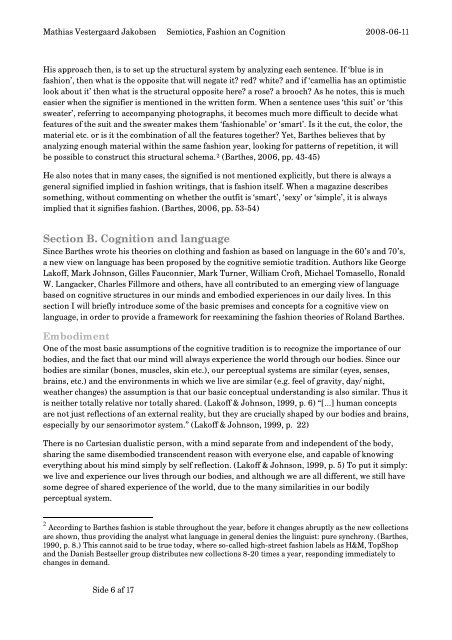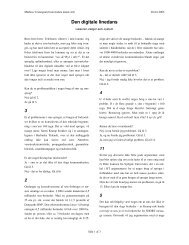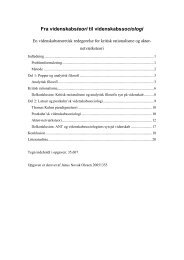Semiotics, Fashion and Cognition - Mathias Vestergaard Corp.
Semiotics, Fashion and Cognition - Mathias Vestergaard Corp.
Semiotics, Fashion and Cognition - Mathias Vestergaard Corp.
You also want an ePaper? Increase the reach of your titles
YUMPU automatically turns print PDFs into web optimized ePapers that Google loves.
<strong>Mathias</strong> <strong>Vestergaard</strong> Jakobsen <strong>Semiotics</strong>, <strong>Fashion</strong> an <strong>Cognition</strong> 2008-06-11<br />
His approach then, is to set up the structural system by analyzing each sentence. If ‘blue is in<br />
fashion’, then what is the opposite that will negate it? red? white? <strong>and</strong> if ‘camellia has an optimistic<br />
look about it’ then what is the structural opposite here? a rose? a brooch? As he notes, this is much<br />
easier when the signifier is mentioned in the written form. When a sentence uses ‘this suit’ or ‘this<br />
sweater’, referring to accompanying photographs, it becomes much more difficult to decide what<br />
features of the suit <strong>and</strong> the sweater makes them ‘fashionable’ or ‘smart’. Is it the cut, the color, the<br />
material etc. or is it the combination of all the features together? Yet, Barthes believes that by<br />
analyzing enough material within the same fashion year, looking for patterns of repetition, it will<br />
be possible to construct this structural schema. 2 (Barthes, 2006, pp. 43-45)<br />
He also notes that in many cases, the signified is not mentioned explicitly, but there is always a<br />
general signified implied in fashion writings, that is fashion itself. When a magazine describes<br />
something, without commenting on whether the outfit is ‘smart’, ‘sexy’ or ‘simple’, it is always<br />
implied that it signifies fashion. (Barthes, 2006, pp. 53-54)<br />
Section B. <strong>Cognition</strong> <strong>and</strong> language<br />
Since Barthes wrote his theories on clothing <strong>and</strong> fashion as based on language in the 60’s <strong>and</strong> 70’s,<br />
a new view on language has been proposed by the cognitive semiotic tradition. Authors like George<br />
Lakoff, Mark Johnson, Gilles Fauconnier, Mark Turner, William Croft, Michael Tomasello, Ronald<br />
W. Langacker, Charles Fillmore <strong>and</strong> others, have all contributed to an emerging view of language<br />
based on cognitive structures in our minds <strong>and</strong> embodied experiences in our daily lives. In this<br />
section I will briefly introduce some of the basic premises <strong>and</strong> concepts for a cognitive view on<br />
language, in order to provide a framework for reexamining the fashion theories of Rol<strong>and</strong> Barthes.<br />
Embodiment<br />
One of the most basic assumptions of the cognitive tradition is to recognize the importance of our<br />
bodies, <strong>and</strong> the fact that our mind will always experience the world through our bodies. Since our<br />
bodies are similar (bones, muscles, skin etc.), our perceptual systems are similar (eyes, senses,<br />
brains, etc.) <strong>and</strong> the environments in which we live are similar (e.g. feel of gravity, day/night,<br />
weather changes) the assumption is that our basic conceptual underst<strong>and</strong>ing is also similar. Thus it<br />
is neither totally relative nor totally shared. (Lakoff & Johnson, 1999, p. 6) “[…] human concepts<br />
are not just reflections of an external reality, but they are crucially shaped by our bodies <strong>and</strong> brains,<br />
especially by our sensorimotor system.” (Lakoff & Johnson, 1999, p. 22)<br />
There is no Cartesian dualistic person, with a mind separate from <strong>and</strong> independent of the body,<br />
sharing the same disembodied transcendent reason with everyone else, <strong>and</strong> capable of knowing<br />
everything about his mind simply by self reflection. (Lakoff & Johnson, 1999, p. 5) To put it simply:<br />
we live <strong>and</strong> experience our lives through our bodies, <strong>and</strong> although we are all different, we still have<br />
some degree of shared experience of the world, due to the many similarities in our bodily<br />
perceptual system.<br />
2 According to Barthes fashion is stable throughout the year, before it changes abruptly as the new collections<br />
are shown, thus providing the analyst what language in general denies the linguist: pure synchrony. (Barthes,<br />
1990, p. 8.) This cannot said to be true today, where so-called high-street fashion labels as H&M, TopShop<br />
<strong>and</strong> the Danish Bestseller group distributes new collections 8-20 times a year, responding immediately to<br />
changes in dem<strong>and</strong>.<br />
Side 6 af 17








